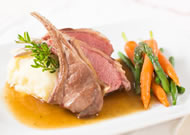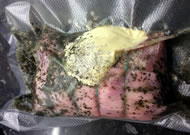Sous-Vide Lamb
Cooking lamb sous-vide

One common problem when cooking lamb in the oven or in a pan is that the edges dry and become tough and chewy – before the centre is even slightly cooked.
Cooking using the sous-vide method allows tougher cuts to break down and tenderise without drying out, for sous-vide lamb that literally falls off the bone. The sous-vide cooking method will gently heat the meat until it reaches the same temperature throughout – this long cooking time will make meat incredibly tender, whilst retaining its full flavour.
You can cook most cuts of lamb in a water bath, from chops and diced steak, to rolled joints and racks of lamb. Sous-vide lamb is so versatile – enjoy succulent steaks with crispy potatoes and green veg, or cook up a tomatoey Middle Eastern dish served with fluffy couscous or rice.
How to cook lamb sous-vide
Cooking lamb in a sous-vide cooker is simple – heat up the water bath, place the vacuum sealed lamb inside, remove, sear, and serve!
For sous-vide to work you’ll need sous-vide water bath or immersion circulator, a vacuum sealer and pouches to keep your food airtight.
Prepare the water bath
Select your desired time and temperature, and wait for the bath to heat up.
For a thick lamb rump, we recommend cooking at 60°C for 1 hour for a medium finish – or scroll down for more ideas.
The Clifton water bath will beep when the water is at the correct temperature – you’re now ready to cook!
Prepare the meat
Different cuts of lamb require different temperature settings and timings for the perfect finish; please use the guide below.
You can pre-season lamb cuts with aromatics or other ingredients before vacuum sealing in a pouch, remembering to place portions in separate bags.
If the lamb has a bone in it, be careful not to pierce the bag when sealing.
Pro tip: Wrap kitchen foil over the end of the bones to stop piercing the bag.
To cook
The Clifton water bath is big enough for a joint of meat, or up to 10 smaller portions (chops or steaks), depending on size.
Place the sealed lamb portions into the bath and cover with the immersion grid to prevent the food rising to the top (lighter items tend to float).
Leave your sous-vide lamb to cook whilst you prepare the rest of the recipe. The timer will beep when it’s time to remove the pouches, or you can leave in the water bath for longer until ready to serve.
Remove & finish
After the lamb has finished cooking, remove from the water bath and set aside for a minute.
For presentation cuts like steak and chops, pan fry in butter or oil over a high heat for approximately 30 seconds each side to brown. Place joints of meat under a grill on high for a couple of minutes, or use a blow torch to create a sizzling crust.
For curries and casseroles, you can add the freshly cooked diced or shredded lamb to the dish before serving.
Times and temperatures
Sous-vide is similar to using a slow cooker, but instead of applying heat directly to the food, a sous-vide cooker contains water which is heated to a certain temperature, and this water gently cooks the food within it. Like with slow cooking, sous-vide breaks down proteins in foods by cooking at a lower temperature over a longer period of time, tenderising meats and locking in flavours.
How long should I cook lamb sous-vide for?
Along with other red meats, cooking times and temperatures depend on the toughness of the cut. Tender cuts of lamb can be cooked at a lower temperature for a shorter time to reach the desired finish, whereas fatty, tough or bone-in cuts benefit from being cooked at higher temperatures for anything up to 36 hours.
Below you’ll find a table with recommended times and temperatures for sous-vide lamb. These are for guidance only – you should adjust the time according to the weight or thickness of your cut of lamb. You can also experiment with temperatures to achieve the texture and colour that you want from your lamb.
Sous vide lamb cooking times
| Rump | Medium Rare | 58°C | 1 hr |
| Medium | 60°C | 1 hr | |
| Shank | Medium Rare | 65°C | 16 hr |
| Medium | 76°C | 10-12 hr | |
| Chop | Medium Rare | 55°C | 2 hr |
| Medium | 60°C | 2 hr | |
| Shoulder | Medium | 60°C | 24 hr |
| Leg | Medium | 60°C | 8-10 hr |
| Cutlets | Medium | 55°C | 2 hr |
| Breast | Medium | 64°C | 18 hr |
| Saddle | 60°C | 35 min | |
| Ribs | 60°C | 36 hr | |
| Rack | 55°C | 2 hr |
These times and temperatures are a suggested guide.
When cooking chops, we recommend a thickness of 1– 1½ inches. If the chops is thicker, please adjust the times and temperatures accordingly.
We recommend having a joint of meat weighing 1–2kg.
How do you know when your sous-vide lamb is cooked?
Sous-vide cooking is a highly precise cooking method – with a precision-controlled sous-vide water bath you can hold the temperature of the water to within 0.2°C. As long as you have correctly worked out the right cooking times and temperatures (according to the above guide), you can be sure your lamb is cooked. Some home chefs like to use a digital thermometer to test the core temperature of the food item, but this is not necessary if you’ve worked out the right times and temperatures beforehand.
The Clifton sous-vide water bath has a handy timer to let you know when your lamb is ready to be served, although you can leave the pouch in the water bath for longer without worrying about overcooking.
Sous-vide is a safe cooking method, provided you follow food safety guidelines and keep within the safe temperature range.
How to select the right cuts of lamb
Pro tip: Remember to save the juices from the pouch to create a delicious sauce or jus!
 Sous-vide is such a versatile cooking method – it’s ideal for cooking all cuts of lamb, from individual cutlets to rolled joints, and even belly of lamb tastes wonderful cooked sous-vide. Cooking lamb long and slow is the ideal way to tenderise. It’s also a stress-free way of cooking cuts like rack of lamb or loin of lamb, ensuring the meat is cooked to the right level throughout.
Sous-vide is such a versatile cooking method – it’s ideal for cooking all cuts of lamb, from individual cutlets to rolled joints, and even belly of lamb tastes wonderful cooked sous-vide. Cooking lamb long and slow is the ideal way to tenderise. It’s also a stress-free way of cooking cuts like rack of lamb or loin of lamb, ensuring the meat is cooked to the right level throughout.For first-time sous-vide chefs we recommend starting with a simple lamb steak or chop recipe – there are hundreds of recipes and flavour combinations to try, as well as experimenting with different temperatures to achieve the perfect pinkness for you.
Reheating lamb with sous-vide
One of the reasons why sous-vide cooking is popular with professional chefs is because it’s easy to pre-cook batches of food to reheat and serve later, reducing the time to service. For the home cook, sous-vide can help you cook large meals in advance, as well as prepping a whole week’s worth of meals at the weekend.
Chilling food for storage
It’s important for food safety, to chill down foods quickly to make sure they’re still safe to reheat and eat. Use an ice water bath to bring down the temperature to under 3°C within 90 minutes, dry off and store in the pouch, in the fridge (keep for up to 4 days).
Reheating lamb using a water bath
Pro tip: Keep lamb in its pouch in the fridge, and reheat in the sous-vide cooker when ready.
 It’s just as simple to reheat your lamb meal again – just place back in the water bath at 5 degrees lower than the original cooking temperature, for half the original cooking time. Reheating below the original cook temperature avoids further cooking of the food item.For a lamb chop, this would be for 30 minutes at 59°C. Finish the dish in the same way as you would with a normal recipe – repeat the last stages such as searing in a hot pan and serving.
It’s just as simple to reheat your lamb meal again – just place back in the water bath at 5 degrees lower than the original cooking temperature, for half the original cooking time. Reheating below the original cook temperature avoids further cooking of the food item.For a lamb chop, this would be for 30 minutes at 59°C. Finish the dish in the same way as you would with a normal recipe – repeat the last stages such as searing in a hot pan and serving.